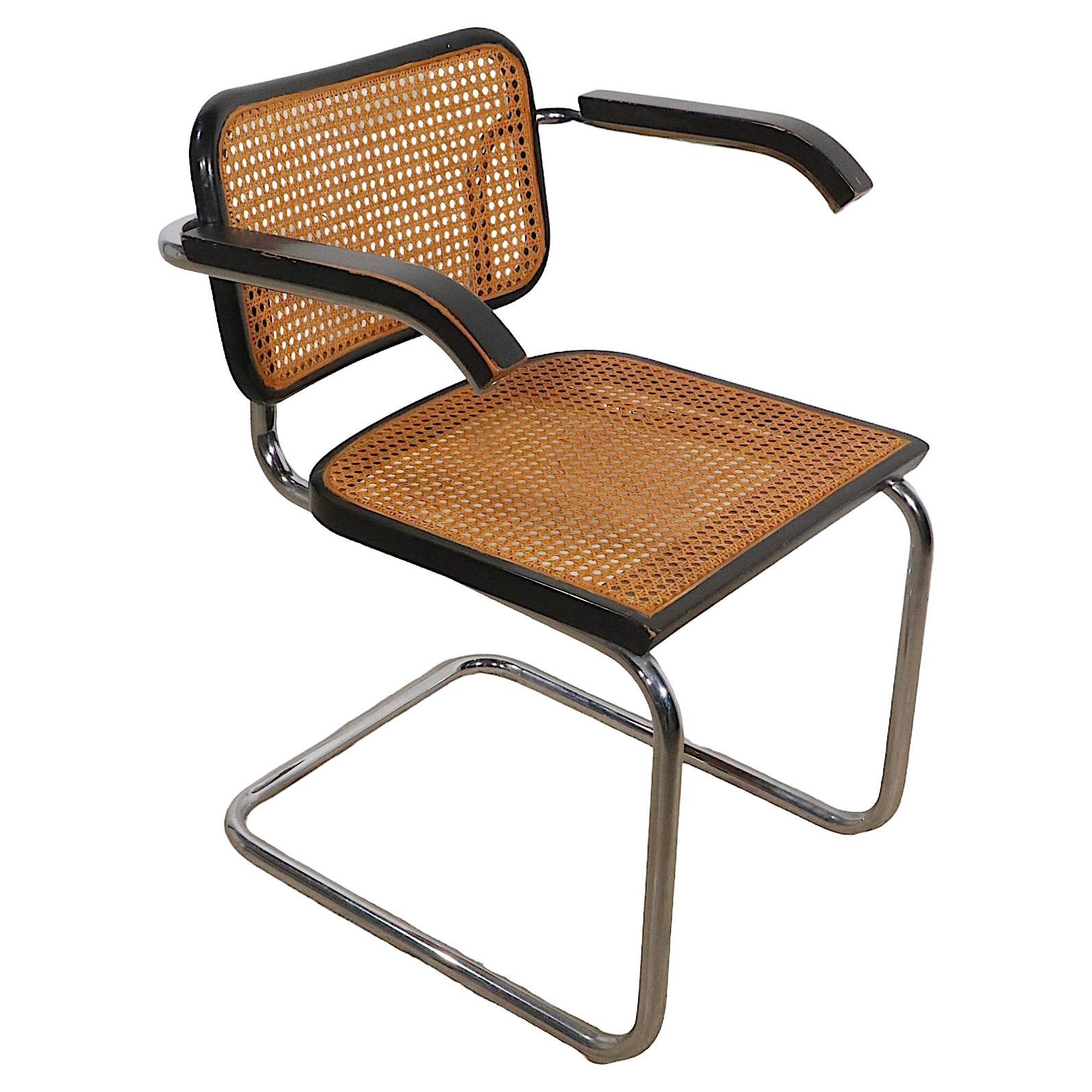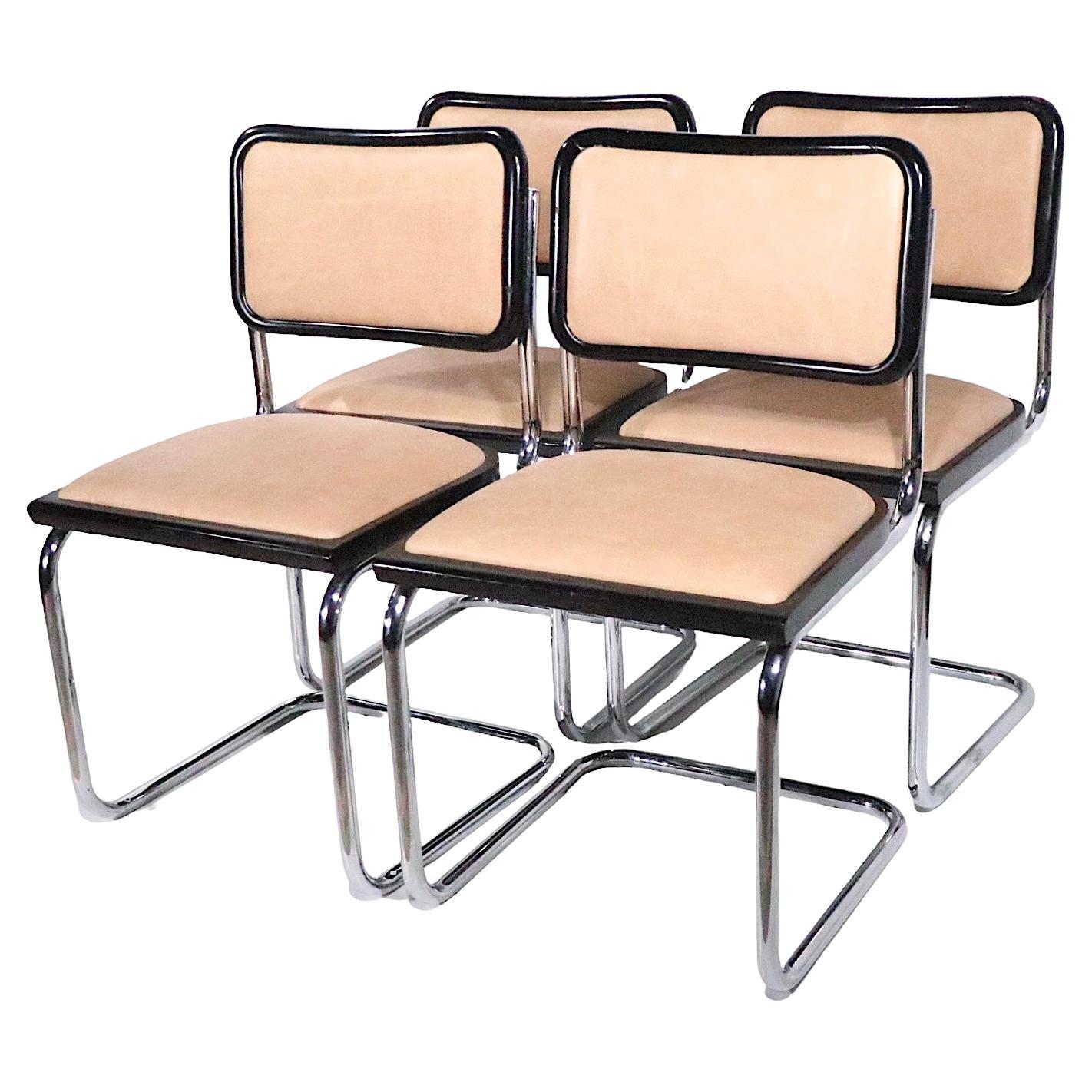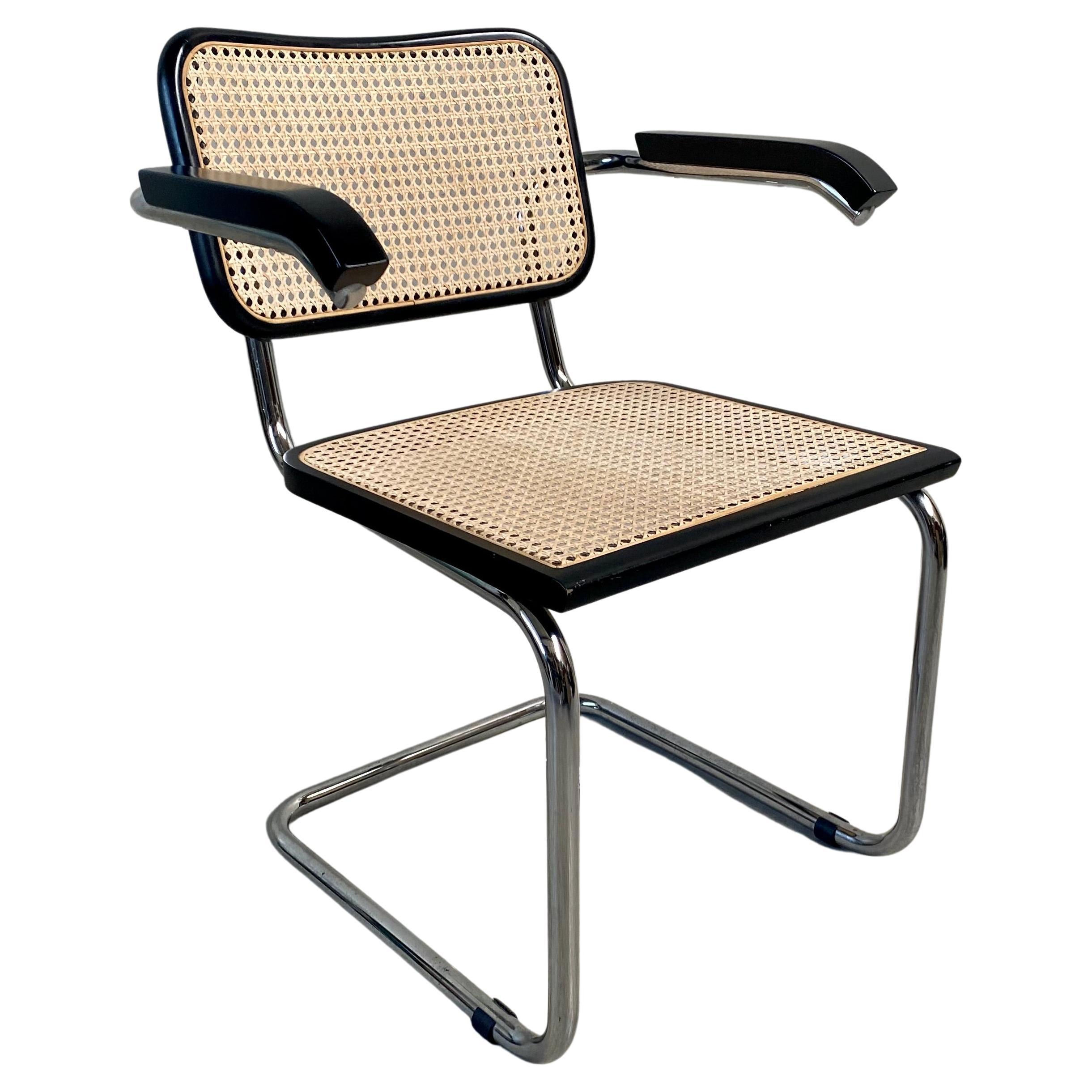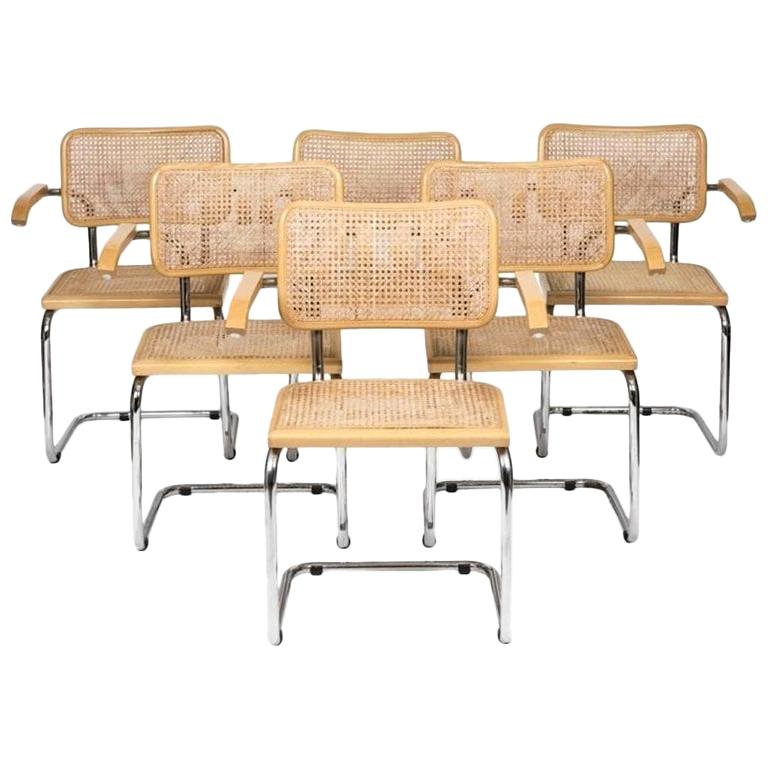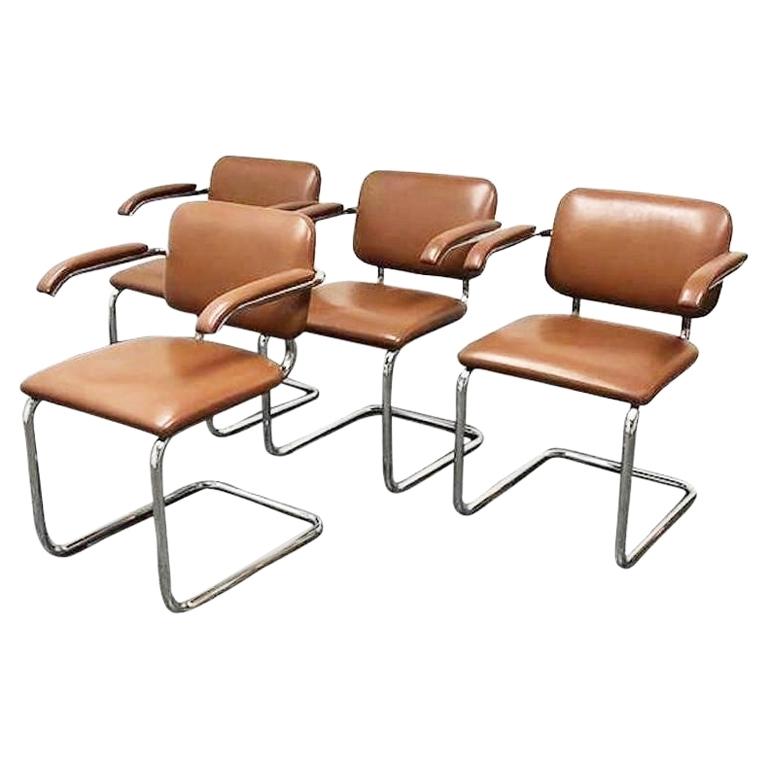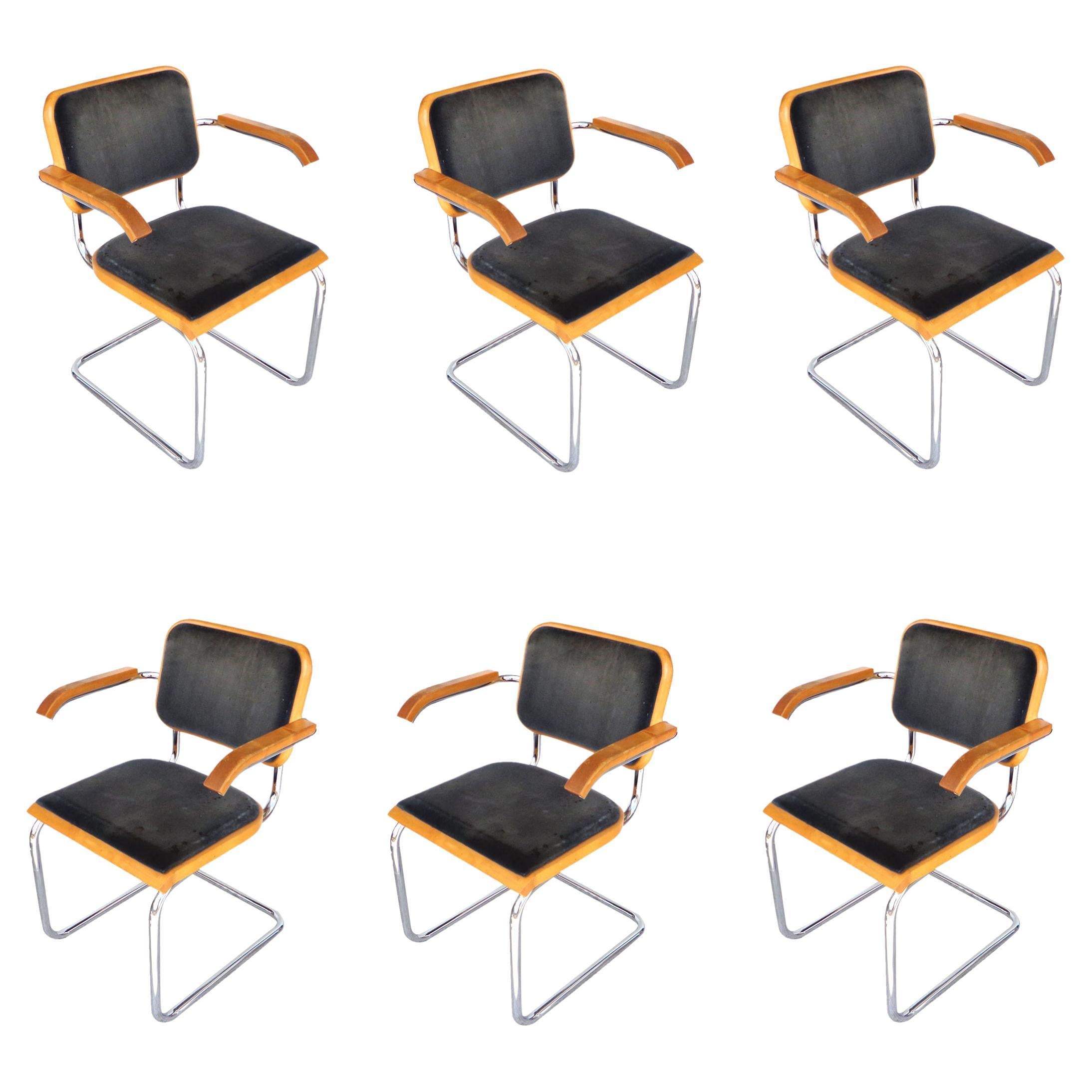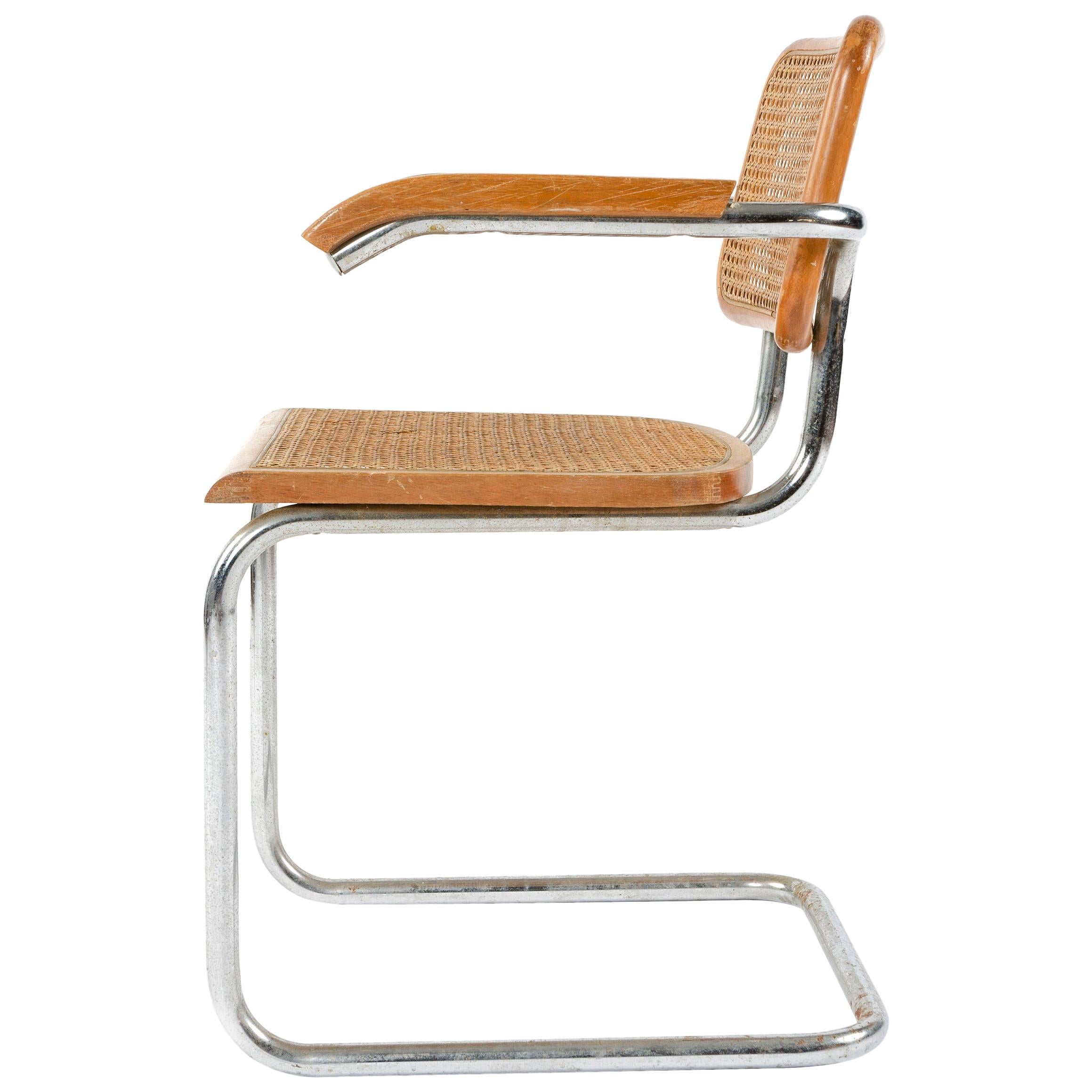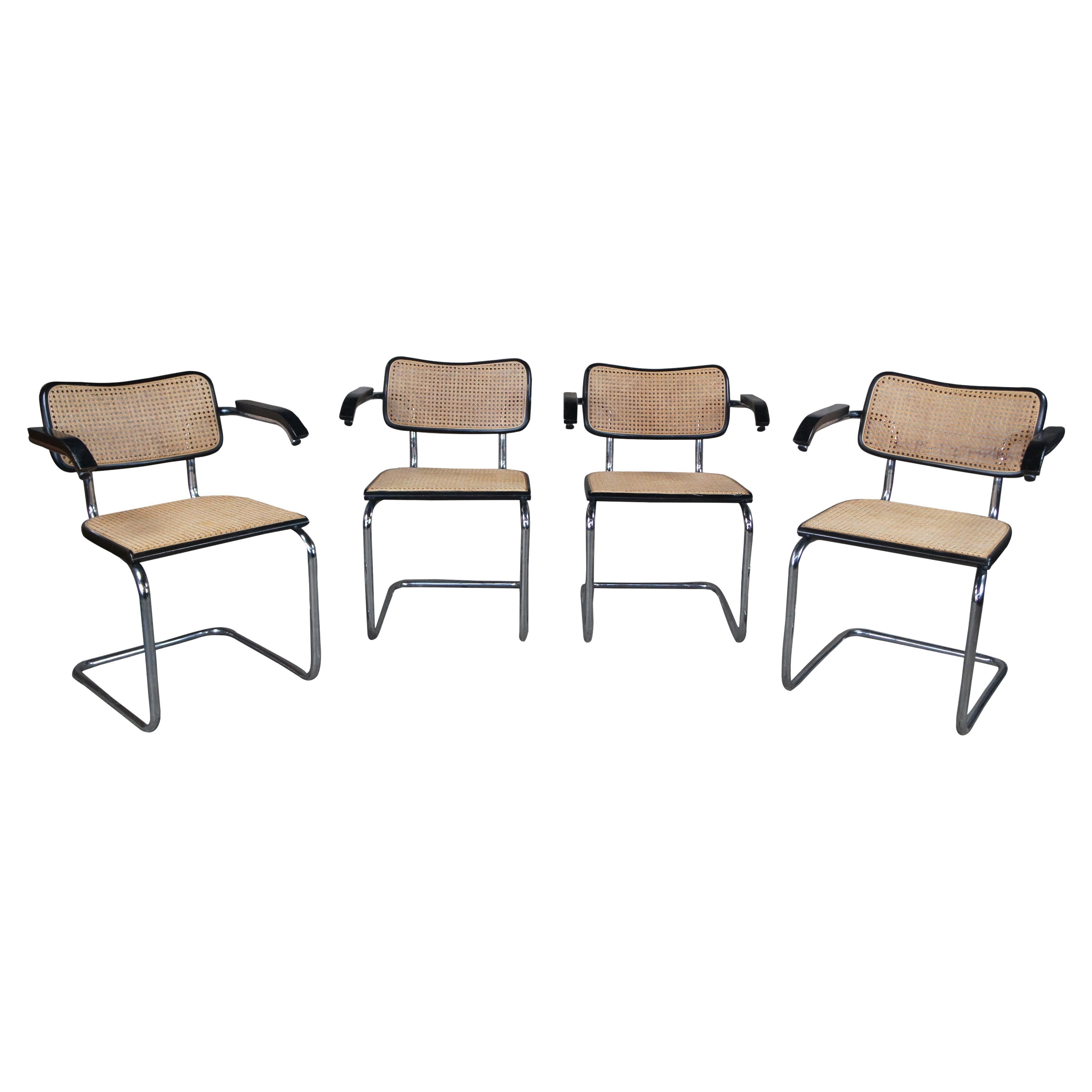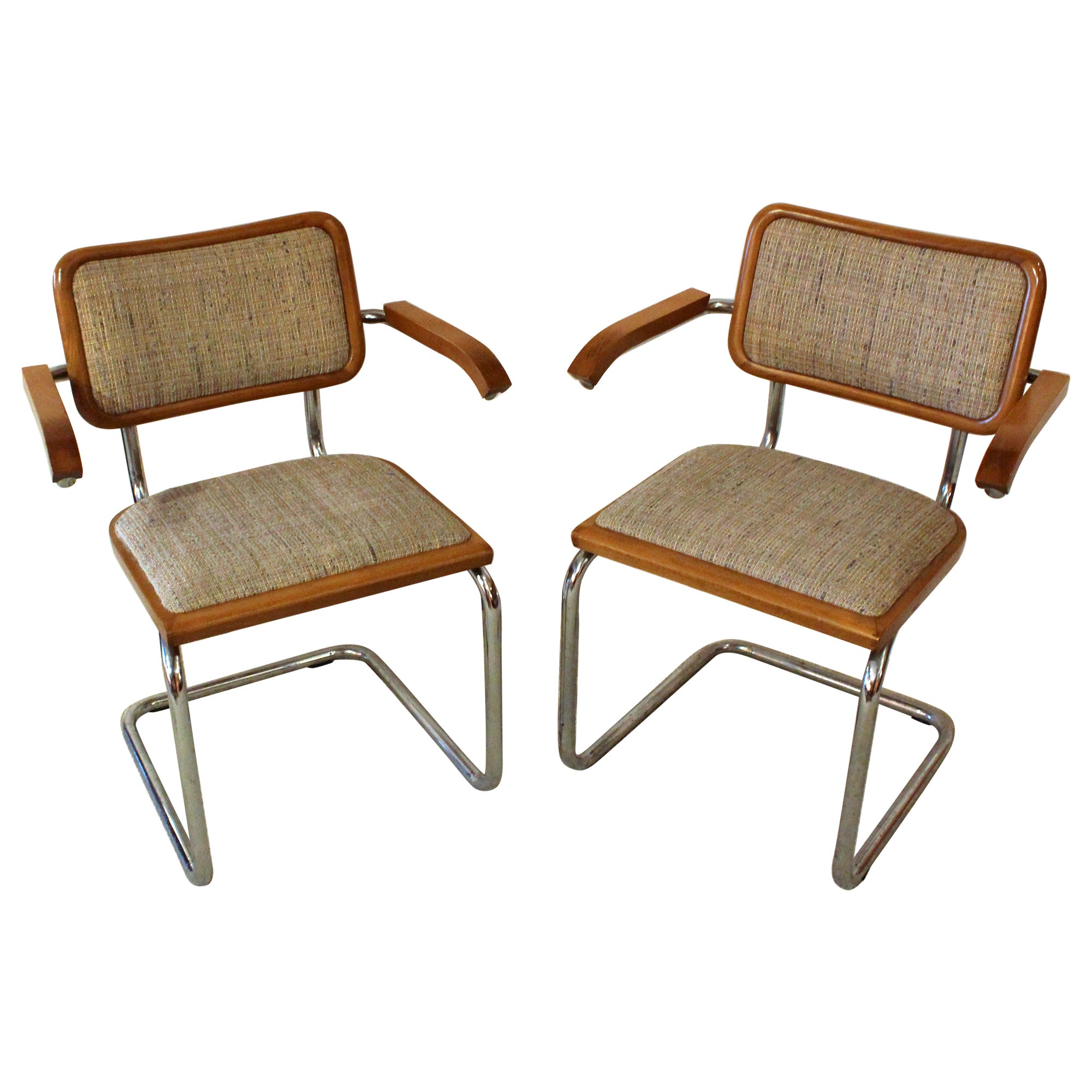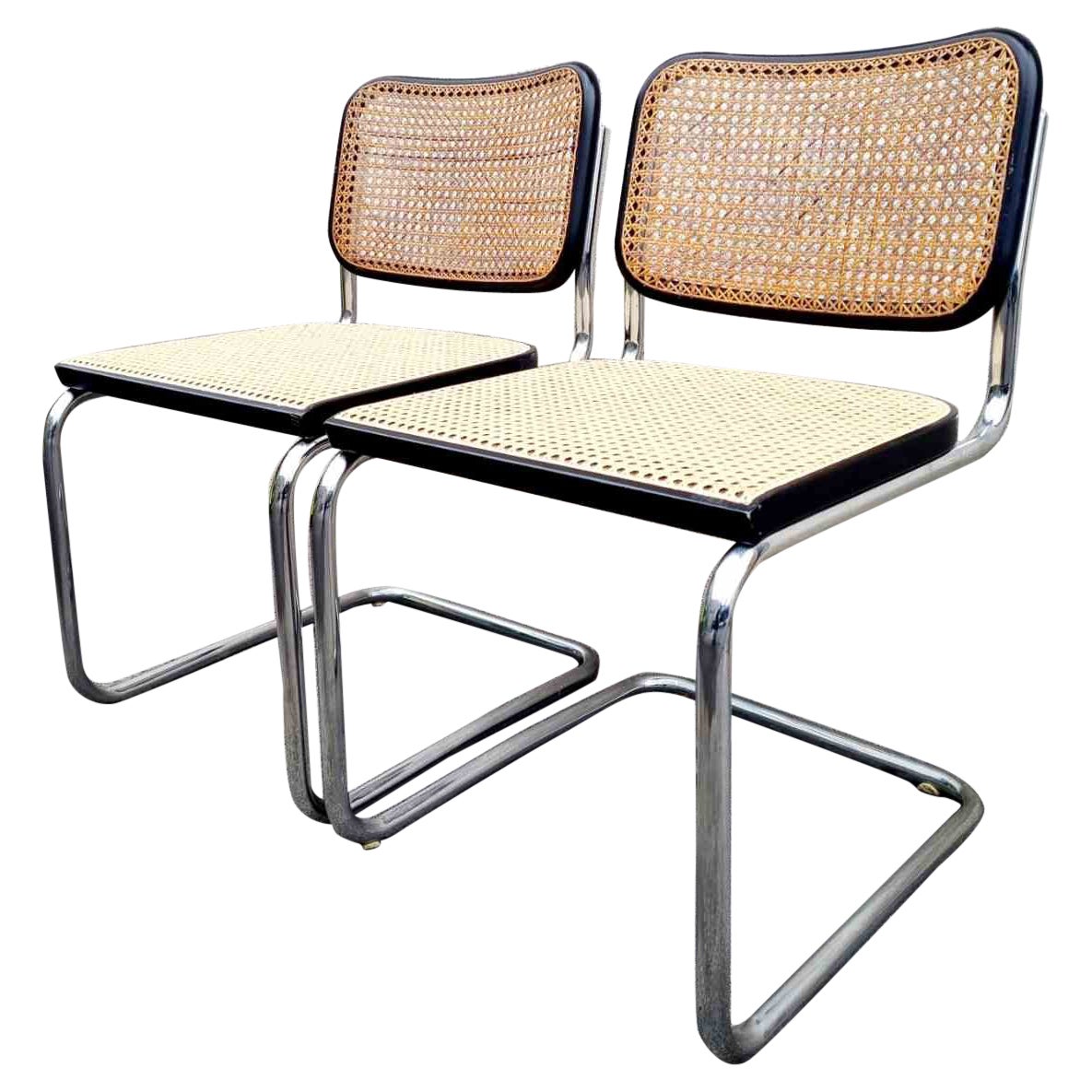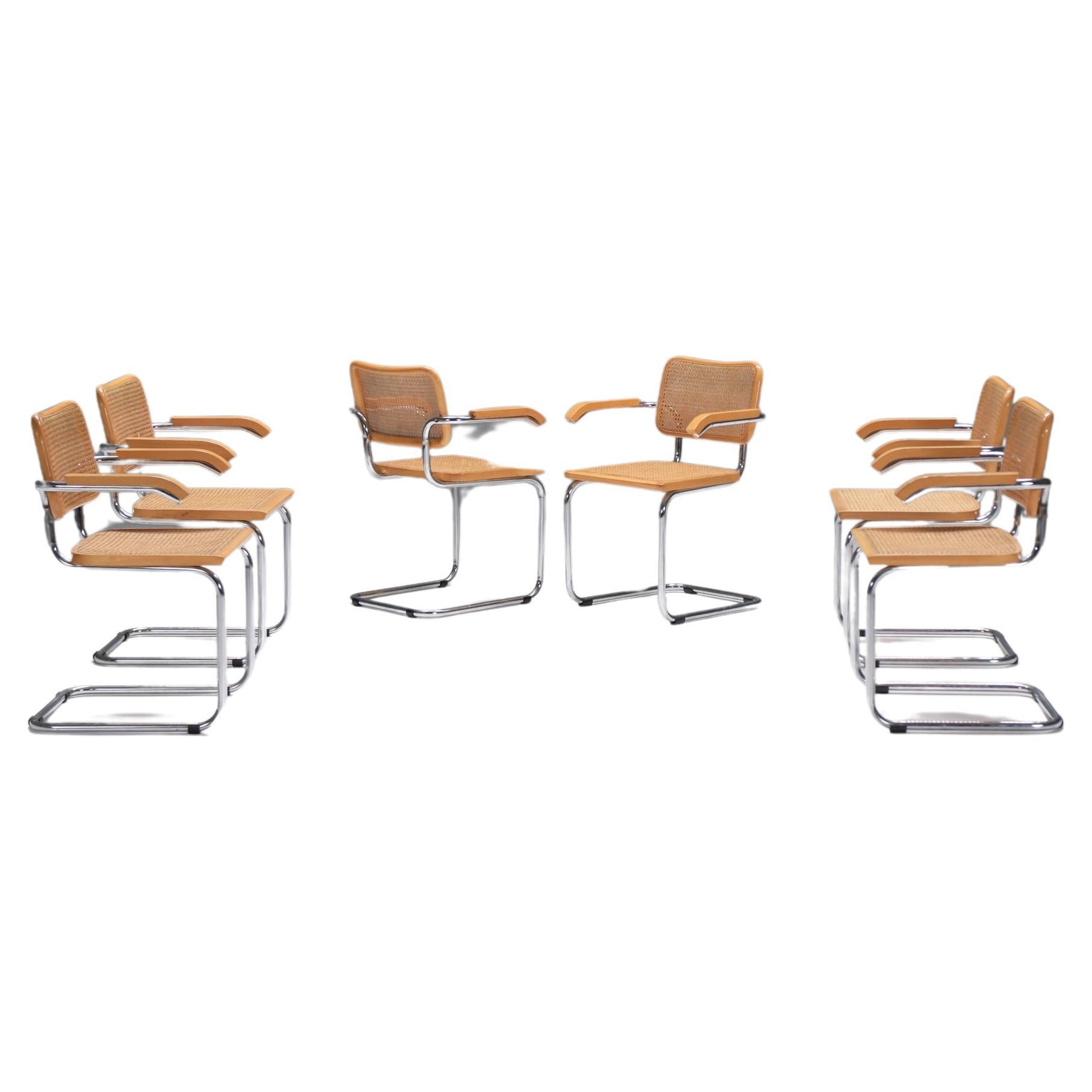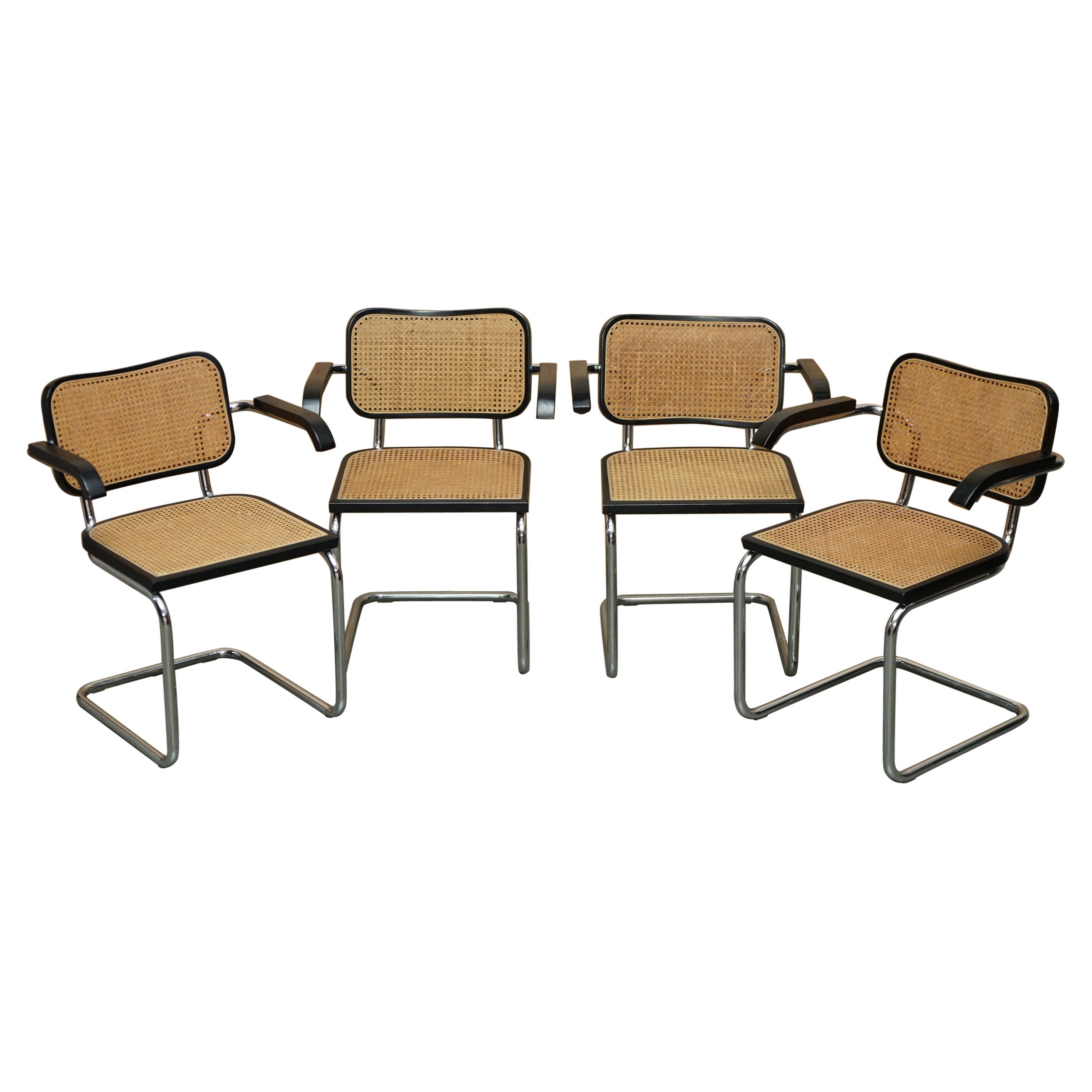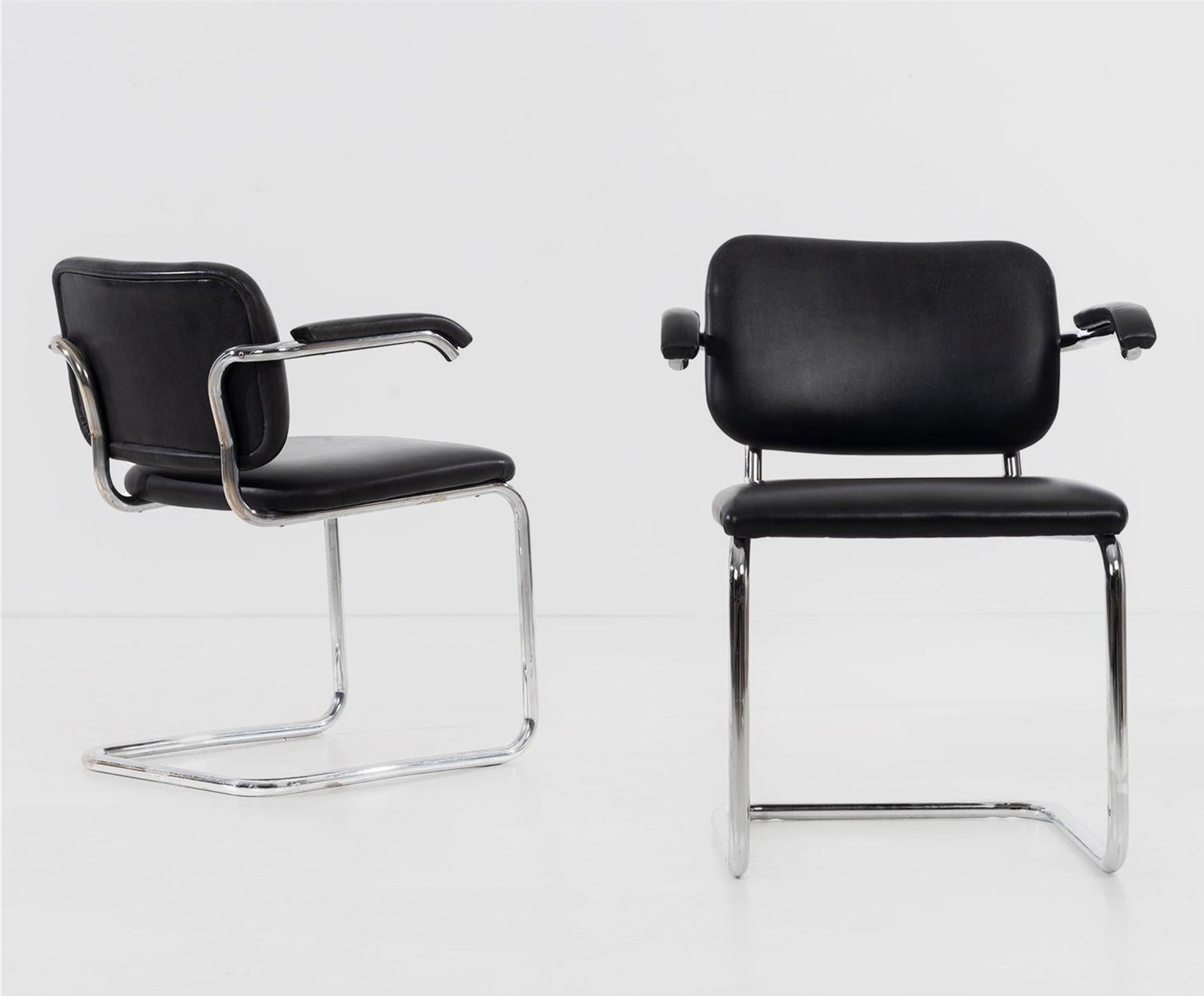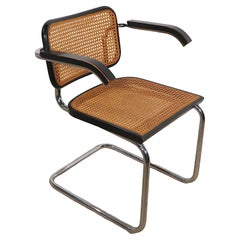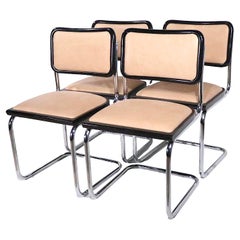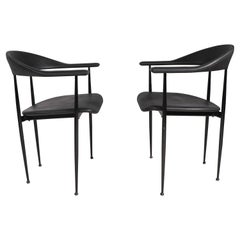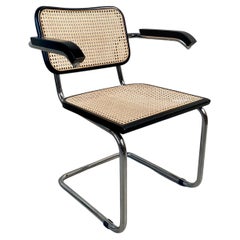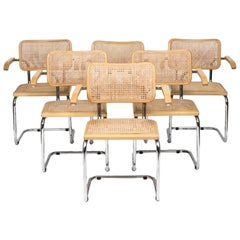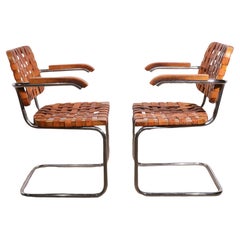
Pr. Unusual Cesca Dining Arm Chairs Designed by Breuer Made in Italy, Ca. 1970's
View Similar Items
Pr. Unusual Cesca Dining Arm Chairs Designed by Breuer Made in Italy, Ca. 1970's
About the Item
- Creator:Marcel Breuer (Designer)
- Design:
- Dimensions:Height: 34.5 in (87.63 cm)Width: 18 in (45.72 cm)Depth: 18.25 in (46.36 cm)Seat Height: 18.25 in (46.36 cm)
- Sold As:Set of 2
- Style:Bauhaus (In the Style Of)
- Materials and Techniques:
- Place of Origin:
- Period:
- Date of Manufacture:1970s
- Condition:Rewoven. Wear consistent with age and use. Solid and sturdy, both show signs of age and use, please see images and description.
- Seller Location:New York, NY
- Reference Number:1stDibs: LU978730253522
Cesca Chair
Ubiquitous but never boring, the Cesca chair has defined casual elegance in the dining room since 1928. Designed by Marcel Breuer (1902–81) for the Austrian furniture maker Gebrüder Thonet, the original Cesca chair combines natural beechwood caning and modern tubular steel for a sensibility that celebrates both handicraft and industrialization. It’s a paragon of Bauhaus design, embodying the school’s “truth to materials” philosophy and adhering to the movement’s emphasis on mass production. In fact, the Cesca chair was the first-ever tubular steel frame chair with a caned seat to be mass produced — a breakthrough for furniture design.
Breuer got his start in architecture after dropping out of the painting program at the Academy of Fine Arts in Vienna. He began apprenticing with a Viennese architect and went on to join the Bauhaus movement in 1921, when he was just 19 years old, eventually becoming a master carpenter at the German arts school. While there, Breuer designed furniture for Sommerfeld House in Berlin, industrialist Adolf Sommerfeld’s private residence, which was conceived by architects Walter Gropius (the Bauhaus school’s founder) and Adolf Meyer. Not long afterward, Breuer’s experiments with tubular steel would yield his Wassily chair, named for his friend, painter and Bauhaus professor Wassily Kandinsky, as well as the Cesca.
Originally called the B32, Breuer renamed the chair in honor of his daughter, Francesca, when Italian manufacturer Gavina began producing it in the early 1960s. Knoll introduced the chair when it acquired Gavina in 1968 and continues to manufacture it today.
And while the Cesca chair’s silhouette has remained the same throughout the decades, Breuer himself later made minor modifications, including the implementation of a shallower curve to the back and the addition of a second piece of steel for the frame to account for both comfort and durability. With the Cesca’s cantilevered construction, Breuer’s design transcended that of the traditional four-legged dining chair, pushing the boundaries of what “everyday” could mean in furniture.
Marcel Breuer
The architect and designer Marcel Breuer was one the 20th century’s most influential and innovative adherents of modernism. A member of the Bauhaus faculty, Breuer — like such colleagues as the architects Walter Gropius and Ludwig Mies van der Rohe, and the artists and art theoreticians László Moholy-Nagy and Josef Albers — left Europe in the 1930s to champion the new design philosophy and its practice in the United States.
Born in Hungary, Breuer became a Bauhaus student in 1920 and quickly impressed Gropius, the German school’s founder, with his aptitude for furniture design. His early work was influenced by the minimalist Dutch design movement De Stijl — in particular the work of architect Gerrit Rietveld. In 1925, while he was head of the Bauhaus furniture workshop, Breuer realized his signature innovation: the use of lightweight tubular-steel frames for chairs, tables and sofas — a technique soon adopted by Mies and others. Breuer’s attention gradually shifted from design to architecture, and, at the urging of Gropius, he joined his mentor in 1937 on the faculty of Harvard and in an architectural practice.
In the 1940s, Breuer opened his own architectural office, and there his style evolved from geometric, glass-walled structures toward a kind of hybrid architecture — seen in numerous Breuer houses in New England — that pairs bases of local fieldstone with sleek, wood-framed modernist upper floors. In his later, larger commissions, Breuer worked chiefly with reinforced concrete and stone, as seen in his best-known design, the brutalist inverted ziggurat built in New York in 1966 as the home of the Whitney Museum of American Art.
Breuer’s most famous furniture pieces are those made of tubular steel, which include the Wassily chair — named after Wassily Kandinsky and recognizable for its leather-strap seating supports — and the caned Cesca chair. Breuer also made several notable designs in molded plywood, including a chaise and nesting table for the British firm Isokon and a student furniture suite commissioned in 1938 for a dormitory at Bryn Mawr College. Whether in metal or wood, Breuer’s design objects are elegant and adaptable examples of classic modernist design — useful and appropriate in any environment.
Find vintage Marcel Breuer seating, storage cabinets and lighting on 1stDibs.
- Chrome and Black Cesca Chair Designed by Marcel Breuer Made in Italy circa 1970sBy Marcel BreuerLocated in New York, NYChic Cesca arm chair, designed by Marcel Breuer. Iconic and timeless Bauhaus chair, still relevant to today’s interior spaces. This chair was produced ...Category
Late 20th Century Italian International Style Armchairs
MaterialsChrome
- Set of Four Cesca Chairs Made in Italy Designed by Breuer c. 1970sBy Marcel BreuerLocated in New York, NYExceptional set of four Cesca chairs, originally designed by Marcel Breuer circa 1920’s, these are later vintage examples, made in Italy circa 1970’s. The chairs are newly reuphols...Category
Mid-20th Century Italian Bauhaus Dining Room Chairs
MaterialsChrome
- Pr Post Modern Arm Lounge Chairs Retailed by Conrans Habitat NYCBy ArrbenLocated in New York, NYStylish pair of post modern design chairs, made in Italy, retailed by Conrans Habitat NYC in the 1990's. Very fine, original clean and ready to use condition. Textured rubber upholst...Category
Late 20th Century Italian Post-Modern Armchairs
MaterialsMetal
- Pr. Mid Century Wrought Iron and Bent Plywood Arm Dining Chars After UmanoffBy Paul McCobb, Arthur UmanoffLocated in New York, NYChic architectural pair of mid century dining height arm chairs, having wrought iron frames with formed plywood seats and backs. Both chairs are structurally sound and sturdy, both s...Category
Mid-20th Century American Mid-Century Modern Armchairs
MaterialsWrought Iron
- Decorative Side or Dining Chair by Paolo Buffa Made in Italy Ca. 1950’sBy Paolo BuffaLocated in New York, NYVoguish, chic mid century style really only the Italians could attain, this gem was produced by master designer Paolo Buffa, and it is in very fine, original, untouched condition. P...Category
Mid-20th Century Italian Mid-Century Modern Dining Room Chairs
MaterialsRush, Wood
- Pr. Illum Wikkelso Design Niels Eilersen Made Danish Mid Century Dining ChairsBy Niels Eilersen, Illum WikkelsøLocated in New York, NYPair of Danish Mid Century Modern arm, or dining chairs designed by Illum Wikkelso, cabinetry by Niels Eilersen, made in Denmark circa 1950's. These classic chairs are constructed of...Category
Mid-20th Century Danish Scandinavian Modern Dining Room Chairs
MaterialsTeak
- Black Dining Chair "Cesca" B32 by Marcel Breuer for Fasem, Italy, 1970By Fasem International, Marcel BreuerLocated in DE MEERN, NLBlack dining chair "Cesca" B32 by Marcel Breuer for Fasem, Italy, 1970s Introducing the iconic "Cesca" B32 dining chair by Marcel Breuer, expertly crafted by Italian brand Fasem in the 1970s. This Classic chair has remained a favorite among interior designers and design enthusiasts alike, thanks to its timeless elegance and unparalleled comfort. Marcel Breuer, the renowned Bauhaus designer, revolutionized the world of furniture design with his innovative use of materials and avant-garde approach. The Cesca...Category
Vintage 1970s Italian Mid-Century Modern Armchairs
MaterialsChrome
- Mid-Century Modern B64 Cesca Chair with Arms by Marcel Breuer, Italy, 1970sBy Marcel BreuerLocated in Marbella, ESChair model Cesca B64, with armrests. Chromed tubular structure, beechwood frames in black color and Viennese natural grid. Excellent condition in general both of the wooden frames, ...Category
Late 20th Century Italian Armchairs
MaterialsSteel
- Set of Four Tanned Cognac Marcel Breuer Cesca Dining ChairsBy Marcel BreuerLocated in Dallas, TXBold and modern, iconic set of four Marcel Breuer's revolutionary Cesca (B32) dining armchairs. The simple design combines an Industrial Age aesthetic of tubular steel inspired by a ...Category
Mid-20th Century Mid-Century Modern Dining Room Chairs
MaterialsChrome
- Set of 6 Thonet Cesca Chairs by Marcel BreuerBy Marcel BreuerLocated in Pasadena, TXSet of 6 Thonet Cesca chairs 1980s Set of four armchairs, model Cesca, designed by Marcel Breuer. Manufactured by Thonet circa 1981 Chrome cantile...Category
Vintage 1980s North American Mid-Century Modern Armchairs
MaterialsChrome
$4,320 Sale Price / set20% Off - 1930s Cesca Armchair by Marcel BreuerBy Marcel BreuerLocated in Sagaponack, NYA minimal Cesca armchair designed by Marcel Breuer featuring caned seat and back on a cantilevered tubular chrome frame. Originally from the Levy House...Category
Vintage 1930s American Mid-Century Modern Dining Room Chairs
MaterialsMetal
- 4 Italian Marcel Breuer Knoll Cesca Tubular Chrome Caned Dining Arm ChairsBy Marcel BreuerLocated in Dayton, OHFour vintage Marcel Breuer Cesca Gavina Knoll dining armchairs. Made of tubular steel / chrome featuring caned seat and back with ebonized frame and arms. Linearity balanced by su...Category
Vintage 1970s Mid-Century Modern Dining Room Chairs
MaterialsChrome
